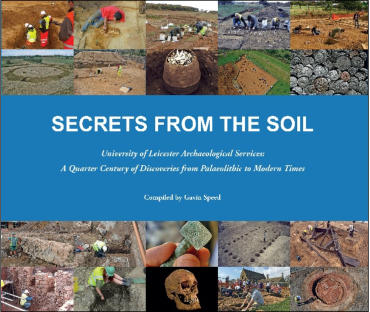Secrets from the Soil -
A Quarter Century of Discoveries from Palaeolithic to Modern Times
By Gavin Speed
Published by University of Leicester Archaeological Services, 2020. ISBN 978-0-9574-7927-2
Available from the University of Leicester bookshop (https://shop.le.ac.uk/)
This
new
publication
marks
the
twenty-fifth
anniversary
of
the
formation
of
the University of Leicester Archaeological Services (ULAS) in 1995.
One
of
the
strengths
of
ULAS
is
being
part
of
the
School
of
Archaeology
and
Ancient
History
at
the
University
of
Leicester,
fostering
close
connections
with
its
research
and
contributing
towards
training
students
to
professional
standards.
ULAS
currently
employs
around
fifty
archaeologists
and
has
completed
thousands
of
archaeological
projects,
often
in
advance
of
housing,
commercial
developments,
new
roads,
pipelines,
and
quarries
within
the
East
Midlands
and
beyond.
However,
most
of
the
projects
are
in
Leicestershire
and
Rutland
and
the
focus
of
this
book
is
on
the
most
exciting discoveries within these two counties.
It
moves
chronologically,
featuring
large
colour
photos
and
reconstruction
illustrations
throughout,
exploring
rarely
seen
Palaeolithic
hunting
grounds;
Neolithic
monuments
and
art;
Bronze
Age
bogs
and
bodies;
the
only
Iron
Age
bark
shield
from
Europe;
Roman
buildings,
mosaics
and
burials;
an
Anglo-Saxon
village;
the
most
complete
Saxo-Norman
timber
structure
in
Britain;
medieval
houses
and
a
brewery;
all
the
way
through
to
Victorian waterways and 1940s bomb shelters.
With
a
bibliography
providing
links
to
further
reading,
this
book
is
ideal
for
those
with
an
interest
in
learning
more
of
the
soil’s
archaeological secrets.
ULAS

Researching Rutland
Copyright © Rutland Local History and Record Society. - All rights reserved
Registered Charity No 700273


Book Review



Researching Rutland
© Rutland Local History and Record Society
Registered Charity No 700273

Book Review
William Browne’s Town: The Stamford Hall Book 1465-1492
Stamford Survey Group in association with Stamford Town Council and
Stamford Civic Trust
Stamford is fortunate to have a Hall Book, a record of the council minutes
of the town. Until now it has remained in the town’s archives only to be
seen by historians with an appointment. With this transcript Alan Rogers
has made the first part of the Hall Book accessible to all and we are given
the opportunity to step back in time and discover what life was really like
in the fifteenth century. Future volumes are planned which will continue
the story of Stamford’s town affairs.
The book gives a remarkable insight into the lives of townspeople in
medieval England covering the years from 1465, shortly after the town’s
incorporation, until 1489 just after the death of William Browne. William
Browne was a very rich and important Merchant of the Staple. He
controlled the affairs of the town during this period, serving as Alderman
on several occasions. His legacy to Stamford is All Saints’ Church and
Browne’s Hospital.
As today, rules and regulations governed the lives of townsfolk. The
minutes record laws forbidding Sunday trading and fines for leaving
horses tied up in the wrong places on market days – as the editor
comments, ‘There were parking penalties even in medieval Stamford’. We
also find that there were designated places for dunghills and times when
animals could be brought into town. From this book we learn how law
and order was enforced and the punishments meted out to wrongdoers.
Perhaps the most interesting aspect of the volume is the tremendous
number of different trades pursued in the town. The wardens strictly
controlled the craftsmen to ensure the quality of goods and there was a
diversity of rules governing the guilds and the pageant of Corpus Christi.
Alan Rogers has had close links with Stamford and readers will no doubt
be familiar with his books The Medieval Buildings of Stamford
(Nottingham 1970), The Book of Stamford (Buckingham 1983) and, with
JS Hartley, The Religious Foundations of Medieval Stamford
(Nottingham 1974). He has also been closely involved with local history in
Rutland, most recently in Uppingham, inspiring and encouraging local
historians to record aspects of the history of that town.
For this volume Professor Rogers has written an excellent introduction
including the insight he has gained about the role of William Browne in
making the transcript. He also adds useful comments throughout the
volume and there is an excellent index. It is a shame that the Editorial
Conventions are not at the front of the book and a glossary would have
been useful for those less familiar with the legal terms of the medieval
period. Do not however be deterred by the plain cover: inside it is a
fascinating record not just for people in Stamford but for anyone
interested in town life in the Middle Ages. It is a book to dip into, and read
aloud it comes to life. It certainly merits a place on the bookshelf of
anyone interested in history.
Jean Orpin







